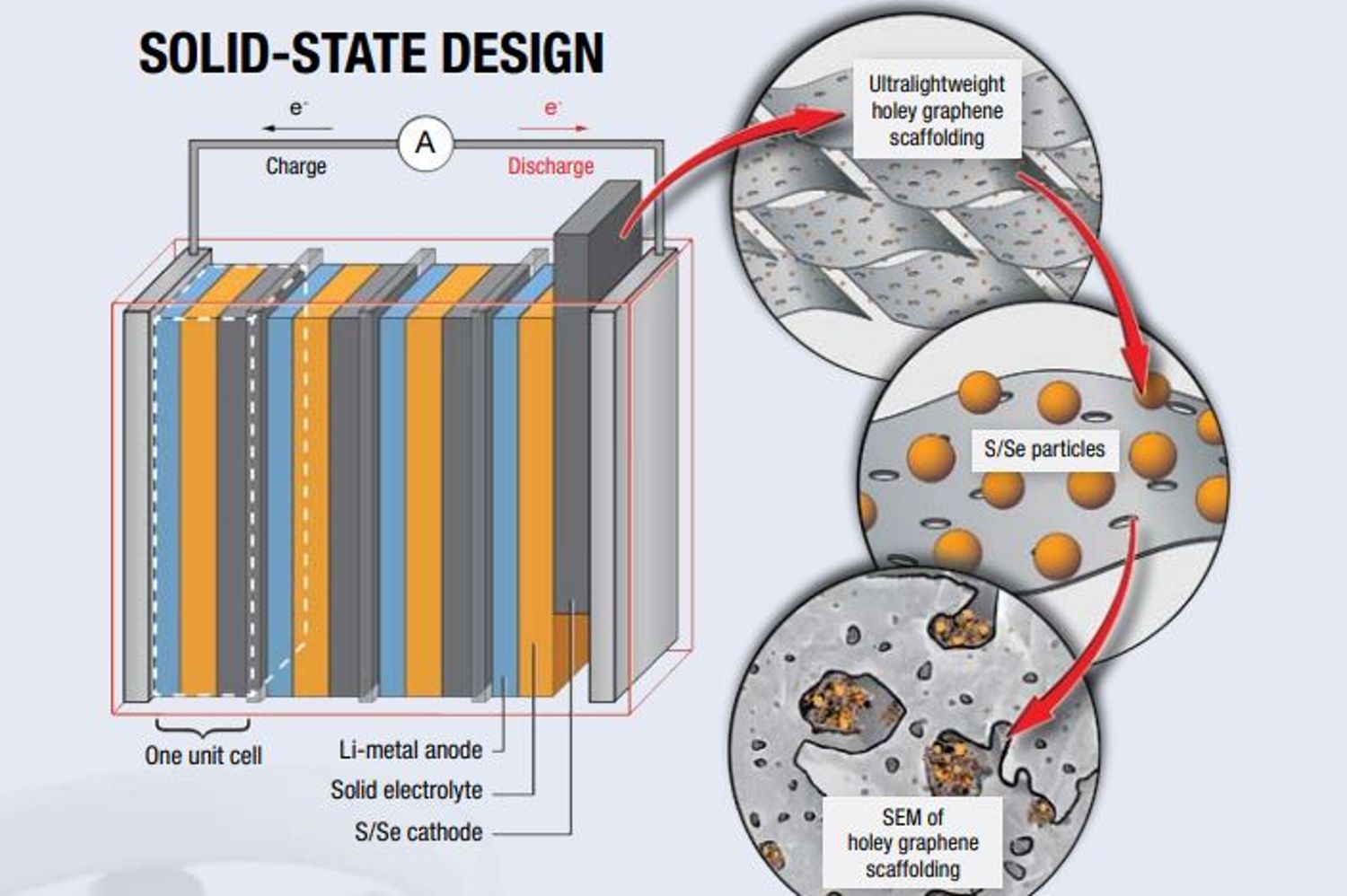Sulfur Selenium Solid-State Battery From NASA Breaks Energy Storage Boundaries
Most of us have little idea what NASA — the National Aeronautics and Space Administration — has been doing since the Apollo moon missions ended. We know it is responsible for Tang and space blankets, but what has it done for us lately?
It turns out, the “aeronautics” part of its mission includes advances in airplanes, and that means finding alternatives to conventional fuels that will leave fewer emissions behind during flight. As any EV advocate knows, vehicles powered by batteries and electricity are far more efficient than conventional cars powered by last century internal combustion technology. But batteries are heavy and bulky — two words that aeronautical engineers never want to hear.
But what if batteries had two or three times more power than today’s best lithium-ion batteries? And what if they also had no liquid or semi-liquid electrolyte inside that could burst into flames? “Fire” and “airplane” are two words that should never be used in the same sentence.
The promise of battery-powered flight is very much on the minds of airline executives who are under pressure to slash emissions from their flights. It also fires the imagination of those who want to bring air taxis into commercial use. The latest news from NASA should be of interest to both groups.
NASA & SABERS
For years, NASA has been researching battery-powered flight as part of its Solid-state Architecture Batteries for Enhanced Rechargeability and Safety program. “SABERS continues to exceed its goals,” said Rocco Viggiano, principal investigator for SABERS at NASA’s Glenn Research Center in Cleveland in a press release last year. “We’re starting to approach this new frontier of battery research that could do so much more than lithium-ion batteries can. The possibilities are pretty incredible.”
Viggiano says a battery is like a bucket that stores energy. More energy storage is like having a larger bucket. NASA says its sodium selenium prototype battery has an energy density of 500 watt-hours per kilogram, which is about double that of conventional lithium-ion batteries.
But aircraft need enormous amounts of power to get off the ground. Until recently, lithium-ion batteries were able to discharge their stored power much more quickly than solid-state batteries could. Now the SABERS researchers, with help from partners at Georgia Tech, have found a way to make their solid-state batteries discharge ten times faster than when the research started. Then they achieved another five-fold increase after that. So now they have a larger bucket that can be emptied rapidly when needed.
That bucket is also up to 40% lighter because of more innovations discovered by the SABERS team. Their sodium selenium battery cells can be stacked one on top of the other with no casing around them. Eliminating the casing around individual cells means more energy storage within a given amount of space — a huge advantage when trying to fit batteries into the structure of an aircraft. It also means the cooling systems for the cells can be smaller and lighter.
There are other advantages as well. The massive amounts of energy needed at the beginning of any flight can cause temperatures inside battery cells to spike. The solid-state sodium selenium batteries from NASA are able to withstand temperatures twice as hot as conventional lithium-ion batteries. In addition, they are less affected by changes in pressure, which occur rapidly after takeoff and while landing. So far, it’s all good news for electric flight advocates.
Are there any drawbacks? Cost is a big factor. And the testing protocols before new components get approved for use in commercial aircraft are far more rigorous than they are for ordinary vehicles. The cost of a sulfur selenium battery for a passenger vehicle might be prohibitive, but being able to spread that cost out over thousands of flights might make more economic sense for airlines and air taxi companies.
Speaking of air taxis, there are two designs currently under consideration. One, supported by United Airlines, uses winged aircraft that need less power to stay aloft once they reach cruising altitude. The other, from Archer Aviation, uses what are basically enlarged drones that need their rotors to be in constant high power use in order to stay aloft, which means they use lots of power all the time and have a shorter range.
NASA Advanced Air Mobility Planning
NASA is very much involved with understanding how advanced air mobility might work. Part of that work involves figuring out how to integrate air taxi, robotic package delivers, and emergency medical services into existing flight corridors so aircraft aren’t bumping into each other in flight.
Aviation industry creatives are already designing ride share air services between home and the airport, NASA says. Remotely piloted and autonomous aircraft will make air travel more accessible to the public than it has been before. NASA is researching how these aircraft can be safely integrated into the existing airspace, and exploring the technology that this new highly digital future airspace will need to be successful.
The agency is looking into design and operation options for situations where aircraft will land and take off, and how the aircraft will be built, powered, and maintained. This and other research will provide insights to help industry create an optimum accessibility environment.
There are currently more than 5,000 public airports in the US. AAM will add new ways for passengers to access these airports. Passengers may travel from rural areas or cities quickly to board commercial airliners, and these same air taxi services would give them increased access to medical care or to purchase goods. Delivery drones could also provide easier access to goods and services.
AAM seeks to create affordable and efficient aviation resources for the general public to allow for more people to easily access new, on-demand services. Like commercial air travel today, accommodations will need to be made to these aircraft to cater to all levels of ability. This could include installing ramps for wheelchair access, specialized seats and seatbelts, and added visual and auditory aids to make the aircraft compliant with the Americans with Disabilities Act.
NASA research areas in air traffic management, automation, noise, and safety will need to be combined to make these operations a reality. Government agencies, industry, and the public will need to combine their efforts to safely integrate this new class of aircraft.
NASA’s vision is to map out safe, accessible, and affordable new air transportation system alongside industry and community partners and the FAA. These new capabilities would allow passengers and cargo to travel on-demand in innovative, automated aircraft across town, between neighboring cities, or to other locations typically accessed today by car.
The Takeaway
We tend to think of NASA as being all about rockets and space stations, but much of its work is focused on real-world transportation solutions that have nothing to do with wealthy travelers who want to take a joyride to the edge of space. We stand at the edge of a transportation revolution that sounds like science fiction — flying robotaxis that whisk us to where we want to go, far above the madding crowd. If that ever happens, NASA will be a big part of making that possible.
I don't like paywalls. You don't like paywalls. Who likes paywalls? Here at CleanTechnica, we implemented a limited paywall for a while, but it always felt wrong — and it was always tough to decide what we should put behind there. In theory, your most exclusive and best content goes behind a paywall. But then fewer people read it! We just don't like paywalls, and so we've decided to ditch ours. Unfortunately, the media business is still a tough, cut-throat business with tiny margins. It's a never-ending Olympic challenge to stay above water or even perhaps — gasp — grow. So ...
Source: CleanTechnica


